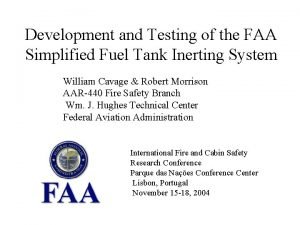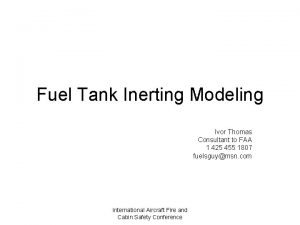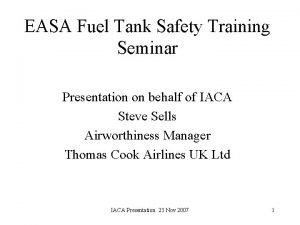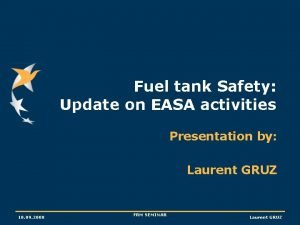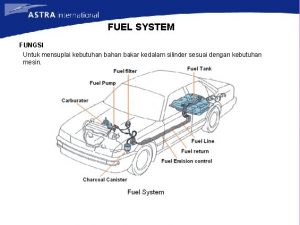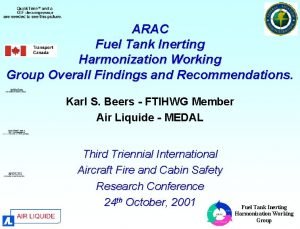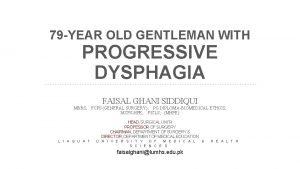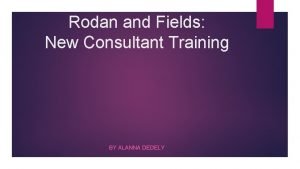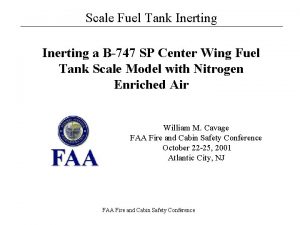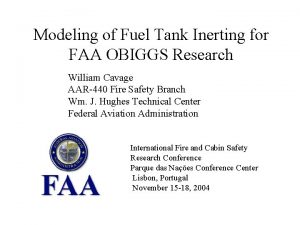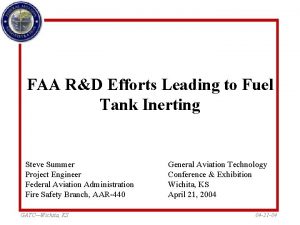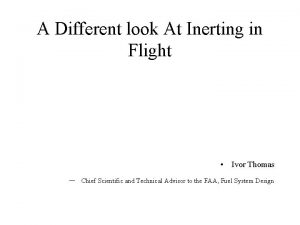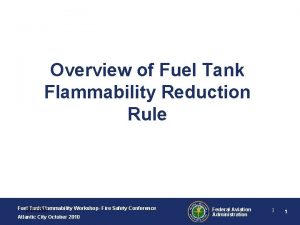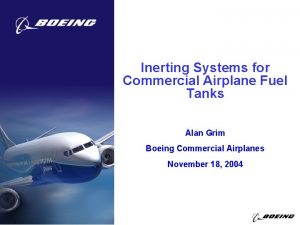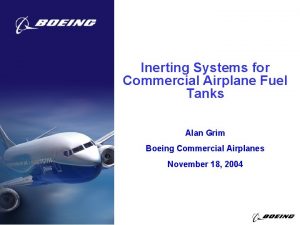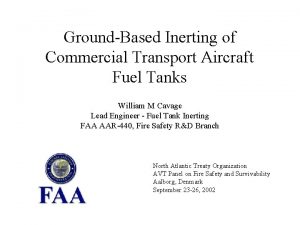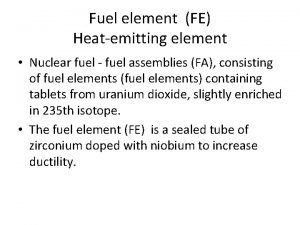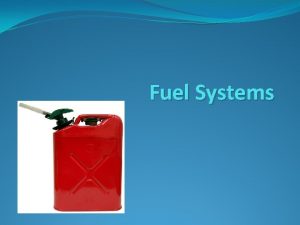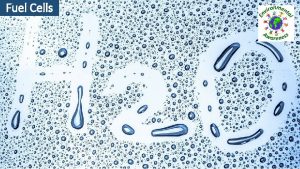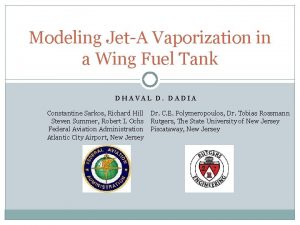Fuel Tank Inerting Modeling Ivor Thomas Consultant to





















- Slides: 21

Fuel Tank Inerting Modeling Ivor Thomas Consultant to FAA 1 425 455 1807 fuelsguy@msn. com International Aircraft Fire and Cabin Safety Conference

Background • Following TWA 800 the FAA undertook to examine fuel tank inerting to determine if a system could be made practical. – Two ARAC studies – FAA lab, ground and flight test programs – Computer simulations of system performance International Aircraft Fire and Cabin Safety Conference

Computer simulations of system performance • Initial model to verify system performance in a single bay tank, using FAA Technical Center tests to confirm model. • Flight simulation model to look at performance of an inerting system throughout a flight • Air Separation Module (ASM) performance in flight (effects of available bleed air, system pressure drop etc. ) • Multi-bay simulations to examine in-tank performance (potential for one or more high oxygen bays when the tank average is satisfactory) International Aircraft Fire and Cabin Safety Conference

Initial Model • Model Features: – Simple one bay tank, – Single source of Nitrogen Enriched Air, at a fixed level of O 2 – Single vent overboard – Sea level conditions only International Aircraft Fire and Cabin Safety Conference

Initial Model • Model Results: – Mixing was very rapid, and could be assumed to be instantaneous – Starting from 21 % O 2 model would predict test results accurately International Aircraft Fire and Cabin Safety Conference

International Aircraft Fire and Cabin Safety Conference

Flight Model • Model Features: – Simple one bay tank, – Single source of Nitrogen Enriched Air, at a variable level of O 2 and flow rate • Changeable for different flight conditions • Could add results of ASM performance for given airplane/engine combination – Single vent overboard – Ground and Flight profiles can be simulated. – Fuel O 2 Evolution and Fuel consumption included International Aircraft Fire and Cabin Safety Conference

Flight Model • Model Results: – Very useful in determining effectiveness of inerting options • Ground based inerting • Various sizes of ASM and flow modes • Substantiated concept of variable flow technique, low flow in climb and cruise, high flow in descent International Aircraft Fire and Cabin Safety Conference

Ground Based Inerting International Aircraft Fire and Cabin Safety Conference

Ground Based Inerting International Aircraft Fire and Cabin Safety Conference

Dual-Flow On Board Inerting International Aircraft Fire and Cabin Safety Conference

Dual Flow On board Inerting International Aircraft Fire and Cabin Safety Conference

Air Separation Module (ASM) • ASM performance strongly affected by available pressure and temperature • Airplane bleed flow affected by airplane flight conditions. • Model combined airplane/engine bleed data with ASM performance data to predict ASM performance in flight, which could then be used in the inerting flight model. International Aircraft Fire and Cabin Safety Conference

Screen Dump of ASM Model International Aircraft Fire and Cabin Safety Conference

Typical Single ASM Performance International Aircraft Fire and Cabin Safety Conference

Multi-bay simulations • Background: • The performance of an inerting system can be estimated with the inerting flight model at a gross tank level. • In-tank effects needed to be examined to understand the potential for bays of a tank to be left at a high O 2 state even though the tank average O 2 was acceptable. International Aircraft Fire and Cabin Safety Conference

Multi-bay simulations • Model Features: – Specific airplane /tank set-up • Bay sizes • Interconnect flow areas • vent geometry, – Multiple NEA insertion points – Ground and Flight Operation – Leakage International Aircraft Fire and Cabin Safety Conference

Multi-bay simulations • Model Approach: – Establish bay to bay flow paths, vent flow paths and any leakage flows – Determine mass changes in each bay for each time increment, based on NEA flow and altitude change and temperature change – Solve for flows between bays and compute resultant O 2 level in each bay – Iterate along flight path International Aircraft Fire and Cabin Safety Conference

International Aircraft Fire and Cabin Safety Conference

Current Status • FAA Multi-bay model developed for specific tanks • NOT available to public as the model uses specific airplane data • Specific model allows examination of different distribution techniques to minimize bay-to-bay O 2 variation, particularly at Landing. International Aircraft Fire and Cabin Safety Conference

Conclusions • FAA computer models, together with a large amount of testing to verify the assumptions in the models have allowed the FAA to understand the potential for On -board inerting systems and has allowed FAA to go forward towards an NPRM to address high flammability fuel tanks. International Aircraft Fire and Cabin Safety Conference
 Fuel tank inerting system
Fuel tank inerting system Fuel tank inerting system
Fuel tank inerting system Fuel tank safety training
Fuel tank safety training Fuel tank safety training questions
Fuel tank safety training questions Fungsi fuel system
Fungsi fuel system Formation fuel tank safety
Formation fuel tank safety Helen c. erickson
Helen c. erickson Dimensional modeling vs relational modeling
Dimensional modeling vs relational modeling Ivor cummings
Ivor cummings Ivor pritchard
Ivor pritchard Tempi chirurgici esofagectomia
Tempi chirurgici esofagectomia Ivor horvat
Ivor horvat Ivor lewis surgery
Ivor lewis surgery Adam gerber md
Adam gerber md Berkeley international office advising
Berkeley international office advising Thomas mocker and thomas stewart
Thomas mocker and thomas stewart Stuart minty camden planning consultant
Stuart minty camden planning consultant Partner technical consultant
Partner technical consultant New consultant training
New consultant training Call script for recruiter
Call script for recruiter Nous hospital consultant
Nous hospital consultant Petrophysics consultant
Petrophysics consultant
